The ASRock Rack W680D4U-2L2T/G5 is one of the really fun platforms from the company. With the latest generation of CPUs, we have not seen Intel have the same focus on its Xeon E line. Instead, ASRock Rack is taking advantage of Intel’s different strategy with the 12th/13th Gen Intel Core processors and turning the workstation-focused W680 chipset with DDR5 ECC UDIMM support, with 10Gbase-T into a server platform. That is the magic behind the W680D4U-2L2T/G5 that we will see in this review.
ASRock Rack W680D4U-2L2T/G5 Hardware Overview
The ASRock Rack W680D4U-2L2T/G5 is a mATX (9.6″ x 9.6″) platform for the LGA1700 socket. One of the big advantages of a mATX platform is that it fits in many chassis both server and pedestal/ tower.
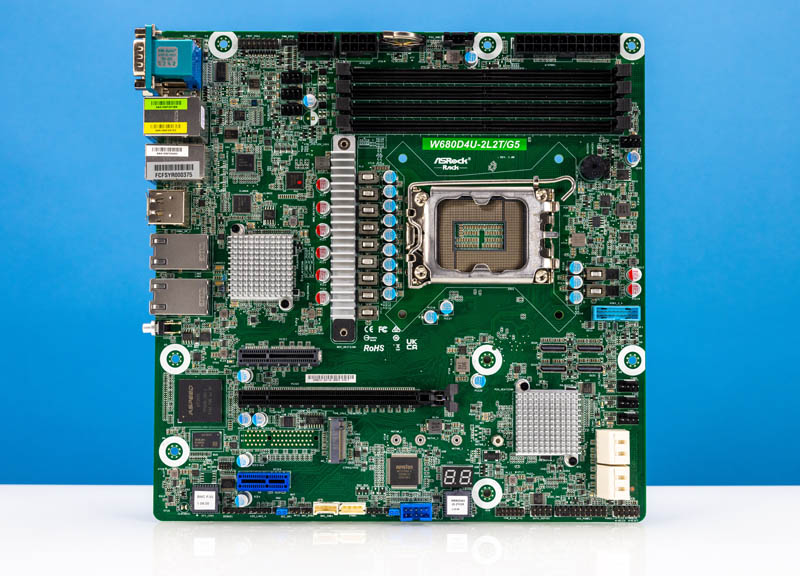
The top of the motherboard is perhaps the most distinctive. Here we have an ATX 24-pin connector and two 8-pin connectors. We have four DDR5 memory UDIMM slots below those. Below the memory is the LGA1700 socket. To the left of the socket are the two Intel i210 NICs and the heatsink for the Intel X710 NIC. Something that is more unique here is that there are three fan headers to the left of the DIMM slots. Normally we see those on the right edge (there are four on the right edge too.) ASRock Rack seems to be contemplating some beefy coolers with this.
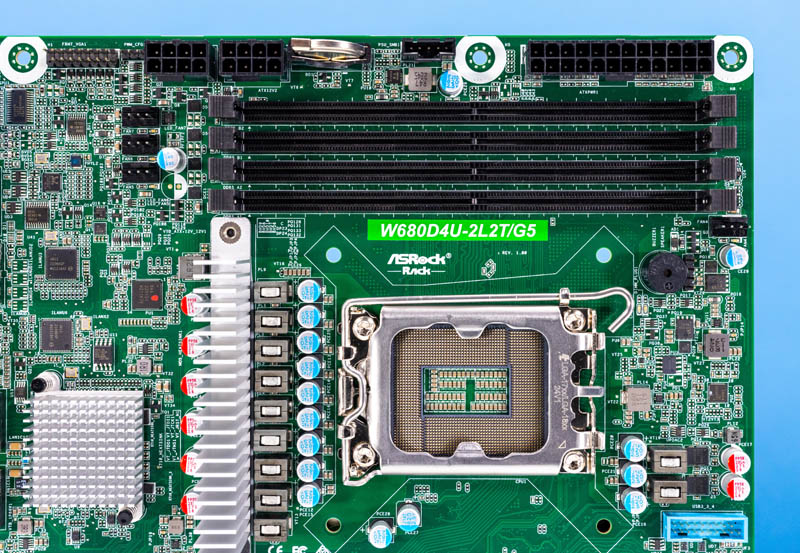
On the memory, because we have a W680 chipset, we get support for non-ECC or ECC DDR5 UDIMMs. In the DDR5 generation, UDIMMs and RDIMMs are not compatible. When many discuss server memory for higher-end AMD EPYC 9004 “Genoa” and 4th Gen Intel Xeon Scalable “Sapphire Rapids” they are referring to RDIMMs. This motherboard only supports UDIMMs. Here is a video on that:
Since Intel is pairing the W680 chipset with ECC UDIMM support with 12th Gen and 13th Gen Intel Core processors, we get something a bit different.
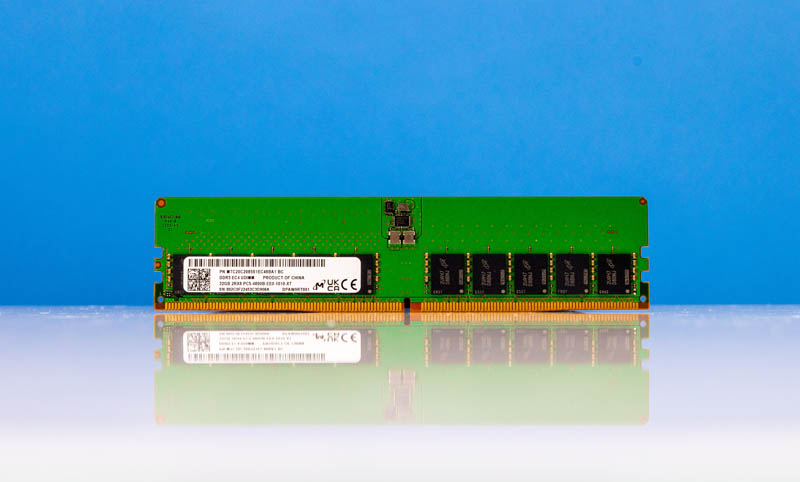
We can use standard Core CPUs and ECC UDIMMs on this platform instead of having to use a Xeon E-line as we did in the past. That is one of the biggest differences between this and the previous generations.
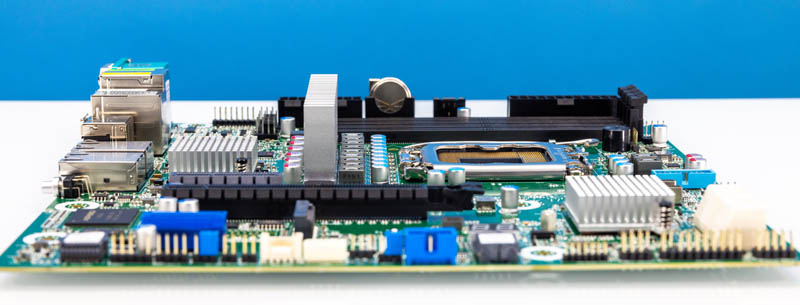
One may ask what is the difference between the ASRock Rack W680 platform and the consumer Z690 platforms other than ECC. A bit one is the airflow arrangement. The entire ASRock Rack W680 platform is set up for front-to-rear (server/workstation) chassis airflow, including the LGA1700 socket, DDR5 DIMM slots, SATA connectors, and more.

The PCIe situation is different from previous versions as well. The PCIe x16 slot is a PCIe Gen5 slot. The x4 slot is a PCIe Gen4 slot from the CPU that shares its lanes with one of the Oculink ports so you can choose slot or Oculink. The smallest slot is a PCIe Gen3 x1 slot to the PCH. This is one of the few motherboards one will see with three generations of PCIe slots next to one another.
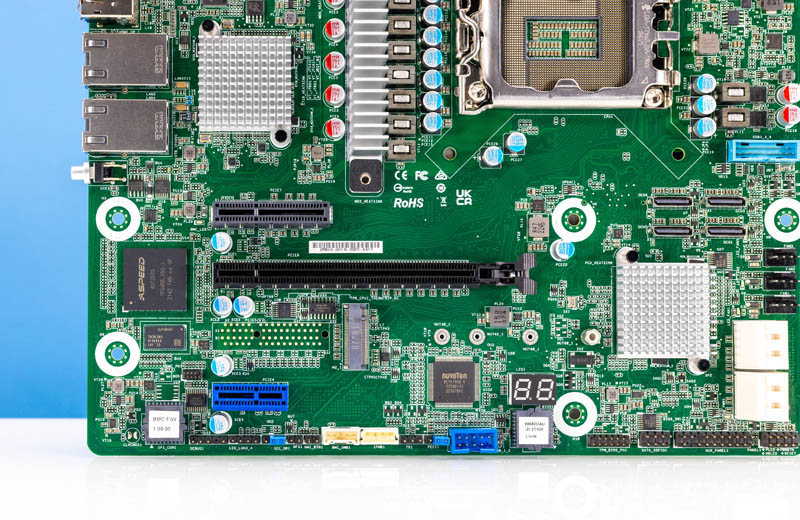
The bottom left has the W680 chipset and four SATA connections. Perhaps the more interesting part of this is that we get a PCIe Gen3 M.2 slot from the PCH and then four Oculink ports. We already mentioned that one Oculink port shares its PCIe Gen4 lanes with the slot. Two of the others are PCIe Gen4 x4 and one is PCIe Gen4 x4 or 4x SATA III all from the W680 PCH.
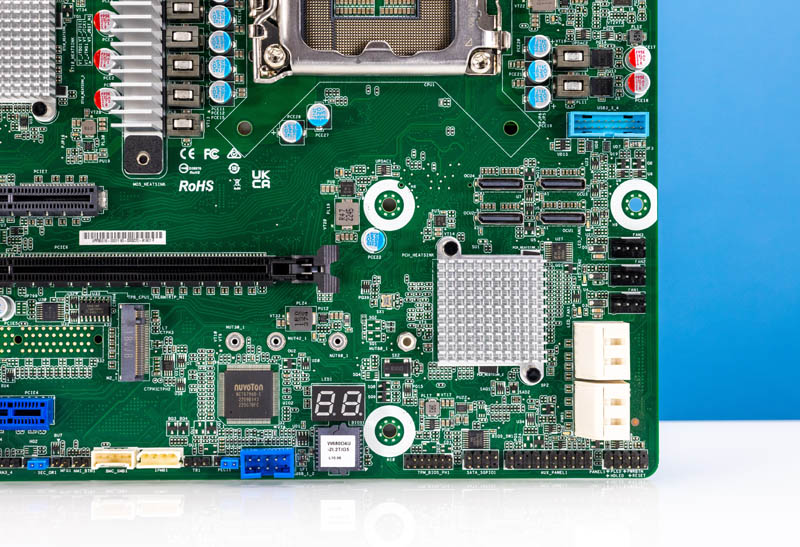
On the rear of the motherboard, we get legacy VGA and serial ports. We also get a management port powered by the ASPEED AST2600 BMC. There are also two USB 3.2 Gen1 ports. Perhaps the most unique is that we get DisplayPort and HDMI ports because the Intel Core processors often have onboard graphics. This is the display output for those.
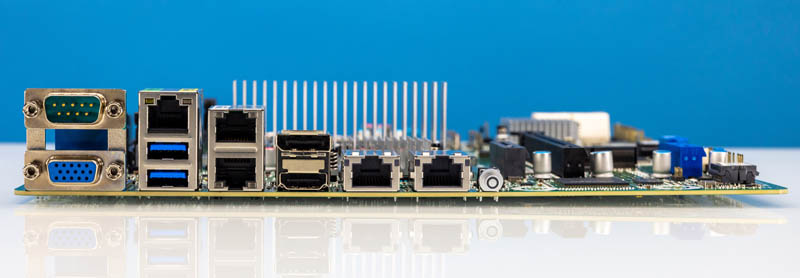
Perhaps the most interesting story though is the networking. We get two Intel i210 1GbE ports. Then on this platform, we get two 10Gbase-T ports from an Intel X710. That is a higher-end NIC than the X550 series so this is really nice. Having both 1GbE and 10GbE onboard will mean that many can use the PCIe Gen5 x16 slot for GPUs instead of for NICs.
This is a really interesting platform overall. Next, let us get to the management.

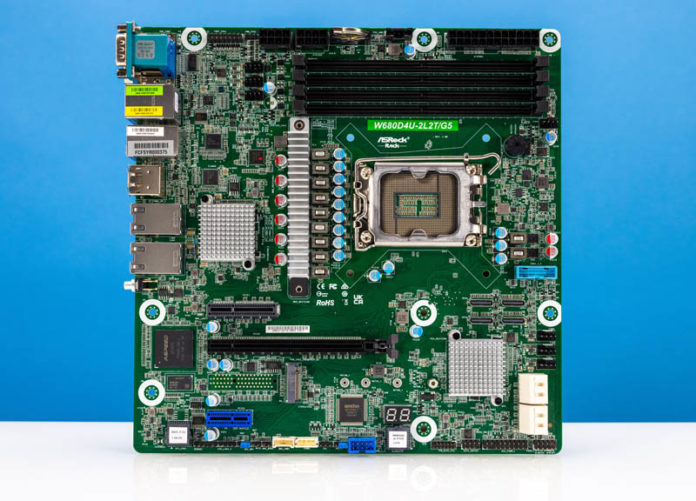



Where can ASRock Rack boards be reliably sourced in the US?
Just a couple notes from my experience with Asrock Rack boards:
The wimpy-looking regulator (and heat sink) may not be representative of performance. I have two passively-cooled C246 systems – the C246 WSI runs significantly cooler than the C246M-WU4 (with similar CPUs). (The “feel test” indicates ~40C vs ~60C, 30C ambient.)
The chipset heat sink is likely a standard part (equivalent to a Wakefield 960), so it’s easy to swap in taller ones if necessary.
The BIOS on the C246 WSI (no BMC) was very basic. How is this one? Or are more configuration options available through the BMC?
It’s a bit frustrating how w680 boards are rare as hen’s teeth – and those that you can find are incredibly expensive.
I want ECC support and vpro but I don’t want to spend three or four times the cost of a motherboard that otherwise does everything I need…
I know this is a stupid question, but it looks like the motherboard has five NIC’s, not only the two 1gb and two 10gb. What is that other Ethernet-looking port?
Idle Power consumption with Ubuntu and maybe with powertop –auto-tune?!
The Asus Pro WS W680-ACE is more in line with high-end consumer boards. It’s in stock in a few places.
I imagine the fifth Ethernet is attached to the BMC.
A nice old-school workstation board with ECC support.
@Garry Perkins in the block diagram it shows the management port being shared with 1 of the i210 1gb NICs. That is a very common BMC design, which I hate and do not recommend, but vendors keep doing it.
The ASRock Rack site does not list and 13th-generation supported CPUs, and they don’t publish BIOS updates, so I find this platform to be attractive on paper but maybe a little scary in practice.
I have this board and I’m frustrated that it’s somehow incompatible with the Samsung 990 2TB M.2 NVMe drive. The drive is recognized in the BIOS and passes the short self-test there, but when I boot an operating system through IPMI virtual media and run lspci, the output doesn’t have the “Non-Volatile memory controller” entry and no corresponding block device is found with lsblk etc. When I swap the 990 Pro for a 970 Pro instead, the 970 Pro shows up in the OS just fine. To make sure there was nothing wrong with the 990 Pro, I put it in my 5-year-old Thinkpad P1 and it shows up just fine there…
The only thing I can think of is the 970 Pro is PCIe 3.0 whereas the 990 Pro is PCIe 4.0. The ASRock board’s M.2 slot can only do up to Gen3 speeds (why?!), but since PCIe is backwards and forwards compatible, it shouldn’t be an issue. I think ASRock messed something up.
I wonder how long it will take for me to reach ASRock and get this issue triaged and hopefully fixed.
Not sure what the point of writing a review of a motherboard that it seems impossible to actually buy is.
@Asrocker experienced same thing with 13th Gen Core on ASUS motherboard. It needed a management engine update. Which is exactly the kind of missing support I alluded to earlier.
@Jeffrey: Do you happen to know the before and after Intel ME versions in your case? I reached out to ASRock Rack technical support on Sunday asking for an updated BIOS image and they responded Monday morning with the 10.07 BIOS .rom file attached. I flashed that version, which they said may contain an updated Intel ME version, but it did not fix the issue. I also forgot to check the exact Intel ME version I had beforehand in case the update did actually update Intel ME (not sure if it did.)
Today I bought a 4TB WD Black SN850X and it also was not recognized, which is alarming. The Samsung 970 Pro continues to work, however. I will let them know that the issue remains after the BIOS update and will ask how to perform an Intel ME update manually. How did you update yours?
Good news! ASRock just published the latest BIOS and BMC firmware files for this motherboard over at https://asrockrack.com/support/index.asp?cat=BIOS yesterday, March 7, 2023.
I updated from BIOS 10.07 Beta (that I was given over email) to BIOS 10.17, and now the NVMe disk shows up in the OS! Interestingly the Intel ME version did not seem to change; it’s still showing 16.1.25.1865 which is the same version I had before updating to BIOS 10.17, and possibly the same version I’ve had since stock as well. Either way, thanks Jeffrey for letting me know that it was something to do with 13th Gen not working well with 12th Gen boards if some components weren’t updated properly (in ASRock’s case, it seems this was the BIOS.)
If you’re lucky enough to get a hold of these, be sure to update the BIOS and BMC firmware from the above link!
Has anyone been able to get ECC memory working on this board? I’m running a 13600K and some Micron ECC 2x32GB from the QVL and while the data/total bus width is detected properly, Windows/Linux/IPMI all report no ECC support.
@TheKeeperOfPie, have you tried the latest BIOS (currently 10.17) from Downloads -> Beta Zone?
Yep, I’m on the latest BIOS and have tried a bunch of things. I started a support thread with ASRock, and the technician claims there’s a DRAM configuration section in the BIOS with an ECC option, but it’s not there on my board.
I’m not sure if something’s actually wrong with my board or if ASRock just forgot to add it to the latest BIOS. For what it’s worth, I don’t think it was on the old version either.
I’ll update if ASRock gets back to me. They seemed fairly responsive at the beginning.
I’m on 10.06 BIOS (came loaded with board) and 16.1.25.1865 ME with a 13500 (didn’t need to update to 10.17) and don’t see any ECC option in BIOS settings either. Hopefully they will release a new non-beta BIOS and get back to you.
Patrick, what was the idle power consumption???
Update to the ECC problem, an ASRock rep shared a beta BIOS with me that exposes the Memory config menu and Windows reports MemoryErrorCorrection 5 now. Hopefully it makes it to the product page downloads soon.
Awesome! Thanks for the update @TheKeeperOfPie. If possible are you able to share the beta BIOS number and Intel ME version?
@Gasmanc, I got one of these recently. With a 12700k, 32gb of Non-ecc Ram at default settings, and with one 10gb NIC connected, here are my measurements with a kill-a-watt after updating to the latest BIOS and BMC firmware on 110V:
– IPMI only: 6.4 W
– BIOS: 45 W
– Unraid booted: 30 W
Splashed out on this board and made sure I updated to latest bios and bmc at time of writing. Windows reports back DIMM temperature but the ipmi has nothing, no sign of it. All other sensors are present. Ive had the b650 and x570 boards and both had it so why not this one? Anyone else have this issue? Everything else works fine with my 12900k.
Saw new BIOS for download, 11.06, updated to it and now have capability to Enable ECC Support under Advanced > Memory Configuration.
Also options to enable ECC DFT and Write0, but unclear to what those are and if they should also be Enabled or not.
Anyone can confirm the use of IPMI and onboard GPU at the same time?
Just wanted to let you guys know how thankful I am for all the information you posted here and for the review. I have ordered this motherboard and hope to pair it with a Intel i5-12600 (don’t need too much performance), 128gigs of DDR5-RAM with ECC, a couple U.2 Samsung 983 NVMe and some WD Ultrastar SATA drives and a Micron 7400 Max m.2 drive.
Never built such a Frankenstein’s monster before, but I decided to do it this time, because the half-baked things I bout pre-built were awful.
Thank you all!